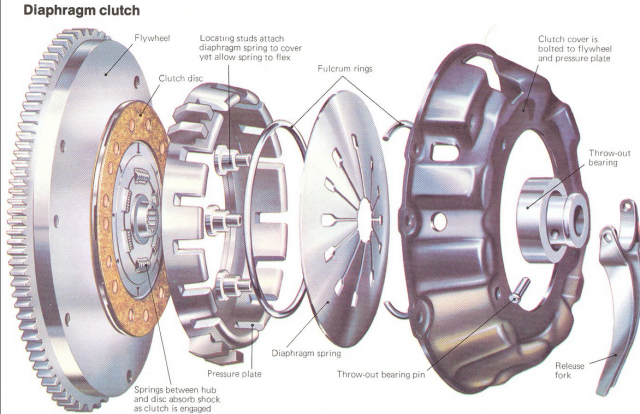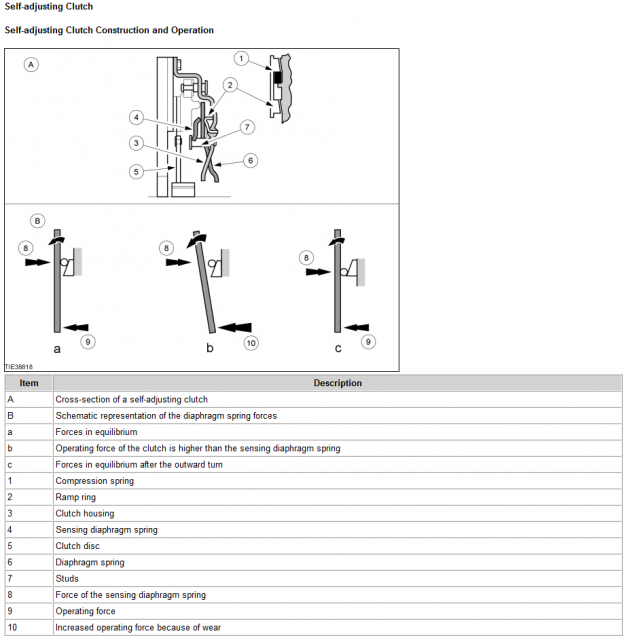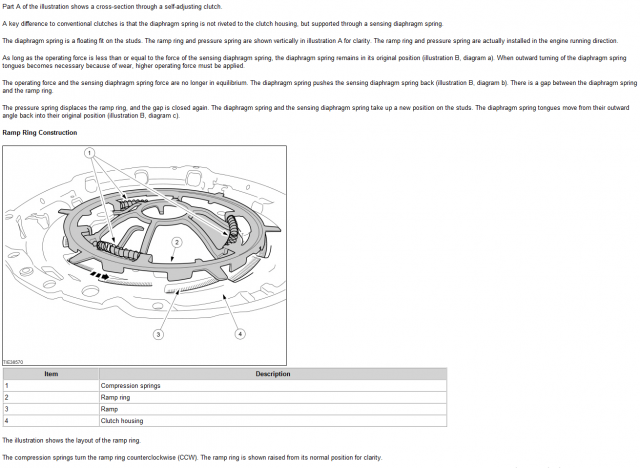Has anyone been able to figure this out? Twice in one month my clutch pedal has stayed to the floor without fully disengaging. What's weird is that the pedal should come back up because of the spring. My fluid is full and there's nothing leaking at the pedal or the trans.
-
Sign Up! To view all forums and unlock additional cool features
Welcome to the #1 Fiesta ST Forum and Fiesta ST community dedicated to Fiesta ST owners and enthusiasts. Register for an account, it's free and it's easy, so don't hesitate to join the Fiesta ST Forum today!
Clutch pedal sticking down, still engaging
- Thread starter SeasickAndrew
- Start date
Has to be a pedal assy or slave issue.
I've heard all these horror stories with bleeding clutch, if nothing is broken it should take seconds to bleed it. I had my clutch line disconnected for a week then reconnected it, then gravity bled it for literally 4 seconds before a steady stream came out and closed the bleeder valve. Clutch feels just like it did from factory.
I've heard all these horror stories with bleeding clutch, if nothing is broken it should take seconds to bleed it. I had my clutch line disconnected for a week then reconnected it, then gravity bled it for literally 4 seconds before a steady stream came out and closed the bleeder valve. Clutch feels just like it did from factory.
I am now part of this club, fortunately I come from swapped subaru hell and didn't panic and just tucked my toe and it popped up off the floor. First and only time in the 6+ months of ownership(hot and humid weather). It's not a CPO but I do have an extended warranty but it's not anything i have or am trying to replicate atm as it was just gentle driving.
So, this happened to me as well (on hot days, but lately they're ALL hot days, so that may be irrelevant...) and I have since pulled the transmission and replaced the clutch, pressure plate, flywheel, and slave cylinder. Everything is in there properly, it drove fine for a week or so and then the pedal stuck down again leaving a light. It seems to only happen when leaving from a stop, and regardless of a hard or soft launch. Right now, I'm waiting on a lift to install a replacement engine and transmission anyway, and I happened to get two clutch pedals in the deal- debating replacing the pedal assembly with one of the ones that came in the Crate-O-FiST that came the other day. Thoughts?
Yeah, I bled mine several times to get all the air out, but it was doing the same thing before I had it apart as well, so that's not it for me. Could be the master cylinder, but if I run out of stuff to do for a bit I'll throw one of the other pedal assemblies in there since I have them anyway. I'll see if it does anything, if it doesn't a master cylinder is the next thing I'll do.
Hello all,
I have an issue with my clutch/clutch pedal that my dealer is having trouble diagnosing. I?ve done a little research and have not seen anyone having the same problem. I figured asking here would be a good next step.
The issue:
Sometimes when I am releasing the clutch pedal, it will only release about an inch, but will fully engage the clutch. I can continue driving & shifting with the reduced pedal travel but obviously when this happens at random it can be surprising and lead to jerky shifts or stalling. It?s as if the clutch is operating normally, but the clutch pedal only moves 25% of its normal range. I can pull the clutch pedal up with my foot and everything seems to go back to normal.This has happened while taking off in first and shifting from 4th to 5th on the highway. The issue has occurred 3 times in the 6,000 miles that I have driven the car.
If anyone could offer any insight into this issue, it would be greatly appreciated.
**Update**
I just got a call from the dealership I'm working with. They were able to replicate the issue and are replacing the clutch pedal assembly. I wasn't able to gather exactly what the issue was, but it seems to be solved for now.
I have an issue with my clutch/clutch pedal that my dealer is having trouble diagnosing. I?ve done a little research and have not seen anyone having the same problem. I figured asking here would be a good next step.
The issue:
Sometimes when I am releasing the clutch pedal, it will only release about an inch, but will fully engage the clutch. I can continue driving & shifting with the reduced pedal travel but obviously when this happens at random it can be surprising and lead to jerky shifts or stalling. It?s as if the clutch is operating normally, but the clutch pedal only moves 25% of its normal range. I can pull the clutch pedal up with my foot and everything seems to go back to normal.This has happened while taking off in first and shifting from 4th to 5th on the highway. The issue has occurred 3 times in the 6,000 miles that I have driven the car.
If anyone could offer any insight into this issue, it would be greatly appreciated.
**Update**
I just got a call from the dealership I'm working with. They were able to replicate the issue and are replacing the clutch pedal assembly. I wasn't able to gather exactly what the issue was, but it seems to be solved for now.
Has anyone been able to figure this out? Twice in one month my clutch pedal has stayed to the floor without fully disengaging. What's weird is that the pedal should come back up because of the spring. My fluid is full and there's nothing leaking at the pedal or the trans.
If you're not loosing any hydraulic fluid, may be an issue with the self-adjust clutch. Self-adjusting clutch... wait, what is that?
We have a hydraulic system connecting the clutch pedal to the clutch assembly. In a traditional clutch design, it's the diaphram springs that provide the return pressure for pushing that pedal back up. The spring on the pedal just makes sure it returns to the bumper so you get that "free-play". (search 'adjust clutch pedal free play engage height') Other than loosing free-play, a weak or non-existent spring on the clutch pedal, should be of no consequence.
But just like our flywheel is far more complex, (and now a potential point of failure,) it turns out that our clutch cover is more complex. Thinking we had a traditional design, I was all ready to point at the clutch hydraulic system; given that this was intermittent. But reading up on this clutch cover spring design, now I'm thinking this part is in play as well; possibly interfering with spring function. See details in the image below, re self-adjusting clutch.
The clutch master cylinder is the cheapest and easiest part to reach. Plus it is capable of leaking internally, as well as externally. The slave can only leak externally. Slave is inside the transmission bell housing; requiring transmission removal. With many car designs, a master cylinder with an external leak, typically puts fluid at the plunger on the firewall. With the slave cylinder being internal on the trans bell housing, unfortunately we can't look at slave cylinder for movement amount and consistency. So there's no easy way to tell if the master has an internal leak.
Traditional Design:

Our Design:


"Crank walk" was an issue for the Eclipses and Talons... not the FiST.
This may be something that you just have to figure out on your own and post back.
We have a light clutch but I'd think there would be enough return force to overcome a pedal assembly that's binding. But number of reports of noisy pedals might be unusually high in occurrence.
https://www.google.com/search?q=site:fiestastforum.com+noisy+clutch+pedal
This is something that is cheap to eliminate from a time and cost perspective. May consider taking it apart, inspecting for damage/wear, lubing it up and reinstalling.
Master Cylinder is cheap. (priced high as far as they go, but still cheap)
https://www.villagefordparts.com/v-2016-ford-fiesta--st--1-6l-l4-gas/clutch--hydraulic-system
Given that "FiST to Death" replaced his clutch components... though I'm not 100% clear that he did the clutch cover assembly.... I'd start with the aforementioned. Only after all of that, would I consider going after the self-adjusting clutch; particularly because people aren't sure of the cause.
Noisy pedal or sticking it to the floor, fortunately is nothing I've experienced at this point.
This may be something that you just have to figure out on your own and post back.
We have a light clutch but I'd think there would be enough return force to overcome a pedal assembly that's binding. But number of reports of noisy pedals might be unusually high in occurrence.
https://www.google.com/search?q=site:fiestastforum.com+noisy+clutch+pedal
This is something that is cheap to eliminate from a time and cost perspective. May consider taking it apart, inspecting for damage/wear, lubing it up and reinstalling.
Master Cylinder is cheap. (priced high as far as they go, but still cheap)
https://www.villagefordparts.com/v-2016-ford-fiesta--st--1-6l-l4-gas/clutch--hydraulic-system
Given that "FiST to Death" replaced his clutch components... though I'm not 100% clear that he did the clutch cover assembly.... I'd start with the aforementioned. Only after all of that, would I consider going after the self-adjusting clutch; particularly because people aren't sure of the cause.
Noisy pedal or sticking it to the floor, fortunately is nothing I've experienced at this point.
Similar threads
-
-
Clutch pedal FEEL issues
- Started by Zeille
- Replies: 13
-
Clutch bleeder nipple is wet after first time experiencing clutch pedal problems - bad bleeder?
- Started by Amaan2018
- Replies: 5
-
Clutch pedal stuck to the floor
- Started by Yoann01ST
- Replies: 17
-
Clutch pedal stuck half way occasionally
- Started by Noahcec
- Replies: 5
-
Clutch pedal sticking on hills
- Started by 0nion
- Replies: 7
-
-
-
Clutch pedal sticking intermittently
- Started by PunkST
- Replies: 20
-
